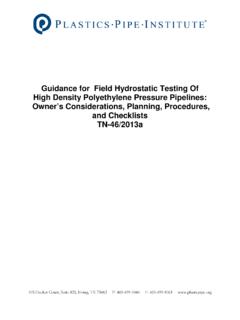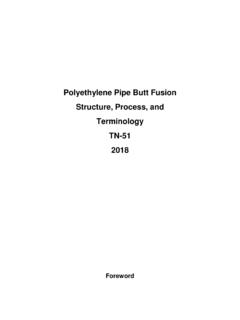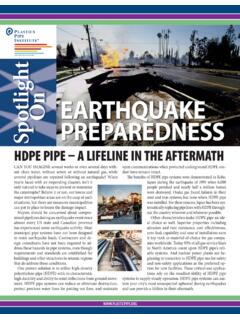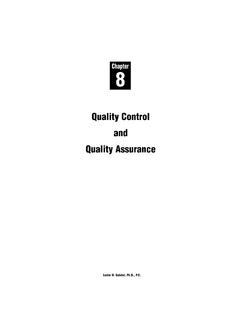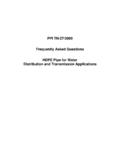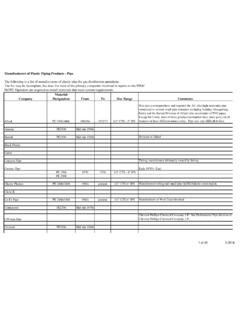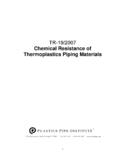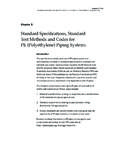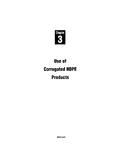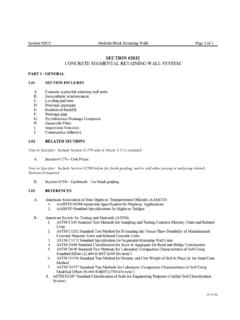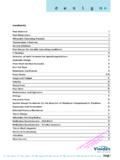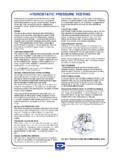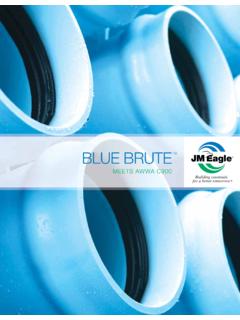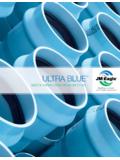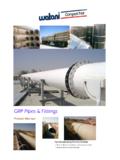Transcription of Long-Term Hydrostatic Strength and Design of …
1 Stephen Boros1 Long-Term Hydrostatic Strength and Design of ThermoplasticPiping CompoundsABSTRACT:There has been tremendous growth in the use of thermoplastic piping systems since theirintroduction more than 50 years ago. They bring a host of benefits in the form of Long-Term performance andreliability, ease of installation, and not being prone to corrosion and tuberculation. It was clear early on thatthermoplastics could not be evaluated in the same way metallic components would be in similar applica-tions. However, over time the understanding of these materials has matured, and as this understanding con-tinues to develop we must not lose sight of the evaluation methodologies used for establishing the long -termhydrostatic Strength of these compounds, and how that Strength has been successfully used in designingthese systems.
2 This paper will give an overview of the basic methodology used to establish the long -termhydrostatic Strength of thermoplastic compounds, and how that Strength is used for engineering Design in asafe and reliable :plastic pipe, Strength , Design , stress, thermoplasticIntroductionThe Long-Term Strength of a thermoplastic compound cannot be determined from a short-term tensilestrength test, as with most metals. As such, testing and evaluation methodologies have been developedwhich take into account not only the stress-rupture response of thermoplastics when subjected to onlyhydrostatic pressure, but that also take into account the potential changes in failure mode when subjectedto stresses induced by other loadings than just Hydrostatic pressure. This more comprehensive evaluationallows for the making of a more engineering appropriate forecast of the Long-Term Strength of these materi-als so they can be safely used in a pressure pipe application [1].
3 The common method for the forecasting of Long-Term Strength relies on putting specimens under mul-tiple continuous stress levels until failure. These data points are then used in a log-log linear regressionevaluation. This regression equation is then extrapolated to a point sufficiently further out in time to wherea Long-Term Strength can be has been clearly established for many thermoplastics, including PE, that a failure mechanism whichoccurs at ambient temperature can be maintained and greatly accelerated by elevating the testing tempera-ture. This acceleration has been shown to follow an Arrhenius, or rate process, behavior that is common tomany chemical and mechanical processes. However, some thermoplastics, such as PVC, do not lend them-selves to these types of accelerated testing methodologies, since they change phase at these elevated testtemperatures and such testing would no longer be evaluating the same material properties.
4 By testing atelevated temperatures it can be validated that the extrapolation remains linear and ductile beyond theactual test data. This and other criteria established by ASTM D2837 and the Plastics Pipe Institute sHydrostatic Stress Board policies in Technical Report-3 (TR-3) allow for establishing an appropriate max-imum working stress that will assure a very long Design life well in excess of the stress regressionextrapolation time [2,3].Establishing the Long-Term Hydrostatic StrengthThere are two primary methodologies established for determining the Long-Term Hydrostatic Strength of athermoplastic material for a piping application ASTM D2837, Standard Test Method for ObtainingHydrostatic Design Basis for Thermoplastic Pipe Materials or Pressure Design Basis for ThermoplasticManuscript received November 11, 2009; accepted for publication June 30, 2011; published online August Director, Plastics Pipe by ASTM International, 100 Barr Harbor Drive, PO Box C700, West Conshohocken, PA of ASTM International, Vol.
5 8, No. 9 Paper ID JAI102850 Available online at Products, and ISO 9080, Plastics piping and ducting systems Determination of the long -termhydrostatic Strength of thermoplastics materials in pipe form by extrapolation [4]. In addition, there is alsoa similar methodology used for thermoset compounds with fiber reinforcement ASTM D2992 [5]. Thesemethodologies are based on similar principles of evaluating the compound under constant stress belowthe short-term tensile yield stress in the form of a pipe and allowing the stress rupture response to bedetermined under these various stress loadings and durations. Using a single or multiple linear regressionmodel, a forecast of the Long-Term Hydrostatic Strength of the material can be made. This is a similarapproach to that used with metals in high temperature applications, such as boiler tubes.
6 However, theseboiler tubes are only exposed to Hydrostatic pressure during service rather than the other potential stressesexperienced in a buried piping application. Additionally, these regression curves for metals are a result of adifferent mechanism than for plastics and cannot be directly compared or applied in the same manner. Theresults from both the ASTM and ISO methods are valid, but it is ultimately the application of the appropri-ate Design factor to establish a safe maximum working stress that is the key. In North America, ASTM standards are the dominant methodologies utilized, so this method will be further examined. A moredetailed analysis of the differences in the ISO and ASTM methodologies are provided in a reference [6].In the 1950s designing with thermoplastics was relatively new and there were no standardized meth-ods to do so in a consistent and reliable manner.
7 In 1958, the Thermoplastic Pipe Division of the Societyof the Plastics Industry (subsequently named the Plastics Pipe Institute) established the Working StressSubcommittee, the predecessor of the Hydrostatic Stress Board. This board consisted of various technicalpersons well-versed in the evaluation and forecast of the Long-Term Strength of plastics. After studying theapplication for several years the first tentative method was developed, and in 1963 the group issued its firsthydrostatic Design stress recommendations for thermoplastic compounds. After evolving through fifteeniterations, this method was published in 1969 as ASTM D2837. The methodology has proven pertinent toall thermoplastic materials, and even thermoplastic based composite pipes, that exhibit a response ofdecreasing rupture Strength when subjected to a continuous are several premises associated with ASTM D2837.
8 It is important to understand that althoughthe material is being evaluated in the form of a pipe, the result is not a pressure rating on the pipe, butrather a Long-Term Hydrostatic Strength of the compound. It is not a trivial idea that a circumferential stressis being induced in the material after it has been formed into a cylindrical shape using traditional extrusiontechniques. Due to the effects of molecular orientation in the extrusion direction, the application of themajor stress in the circumferential direction is considered to be the worst case condition for evaluationof the average value of the stress that is generated in the thermoplastic pipe is calculated using a thin-wall pressure vessel equation which takes the stress at the mid-wall of the pipe.
9 Since most thermoplasticshave a relatively low elastic modulus (compared to metals) it is considered that this method is appropriatefor even heavy wall pipeS PD t 2t(1)where: S Stress, psiP internal pressure, psigD average , inchest minimum wall thickness, inchesThe D2837 test method requires that a minimum of 18 pipe specimens are placed on Hydrostatic testat various stress levels so as to produce failures over at least 3 log decades in time (Table1).TABLE 1 Minimum data point distribution for ASTM on TestNumber of Failure Points<1000At least 610 1000At least 31000 6000At least 3 After 6000At least 3 After 10,000At least 12 JOURNAL OF ASTM INTERNATIONALThe data are analyzed by linear regression using a linear least squares approach to yield a best fit log-stress versus log-time straight line equationh a bf(2)where: h logarithm of failure time, hoursf logarithm of failure stress, psiEven though it is traditional to plot log stress (r) on the y-axis and log time (t) on thex-axis, theD2837 regression calculation is performed in the traditional manner where stress (r) is the independentvariable for the least squares calculation.
10 Conversely, for the evaluation of thermoset compounds, ASTMD2992 performs the linear regression calculation using time as the independent variable. This D2837methodology yields a somewhat lower forecast of the Long-Term Hydrostatic Strength . While different fromD2837, this forecast can still be used for Design purposes as long as the chosen Design factor adequatelytakes this into straight line equation, on a log-log scale, is used to extrapolate the expected Strength to the100 000 h intercept. This stress value is called the Long-Term Hydrostatic Strength (LTHS). While it is con-venient to analyze this stress-rupture data in a log-log scale, it is apparent that the creep response slope isnot linear, as shown in , with Cartesian coordinates. It can be seen that very early failures that aremore indicative of a quick burst type test result in stresses that approach the tensile yield stress obtainedby ASTM D638 using tensile bars with a strain rate around 2 The curve starts to flatten outrather quickly; normally around one to ten hours depending on the type of material, and beyond 100 000 hthe curve has become rather flat and approaches an almost of this near asymptotic response, and the imposed limitation of extrapolating to only one logdecade in time beyond the actual test data, it was determined that extrapolation of the stress-regressiondata from 10 000 h of actual test data to 100 000 h is an appropriate time for establishing the long -termhydrostatic Strength of the material.
